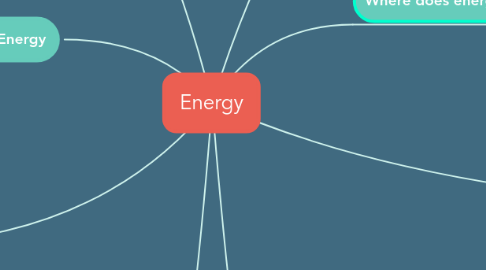
1. Forms
1.1. Potential
1.1.1. Gravitational
1.1.2. Chemical
1.1.3. Nuclear
1.1.4. Elastic
1.1.5. Light
1.2. Kinetic
1.2.1. Motion
1.2.2. Thermal Energy and Temperature
1.2.3. Sound
1.2.4. Electromagnetic Radiation
1.2.5. Electric
2. Everyday Examples Of Energy
2.1. The motion of a vehicle on the street is motion energy.
2.2. A dog's bark is sound energy.
2.3. A battery is chemical energy.
2.4. A song playing on the radio is sonic energy.
2.5. The sun is an example of solar energy
3. Classifications
3.1. Mechanical Energy
3.2. Thermal Energy
3.3. Electrical Energy
3.4. Electromagnetic Radiation
4. Kinetic Energy
4.1. Energy that a body possesses by moving.
4.2. Types
4.2.1. Mechanical
4.2.2. Thermal Energy and Temperature
4.2.3. Sound
4.2.4. Radiant
4.2.5. Electric
4.3. It can be measured in joules.
4.3.1. K.E. = 1/2 m v2
4.4. Factors that it depends on are the mass of an object, and speed of an object.
4.5. It is related to mass because it depends on how much mass it is exerting force on to figure out how strong the force will be.
4.6. It is related to speed because the velocity that it is going at depends on how much mass it is pushing, and how much energy is exerted.
4.7. Real World Examples
4.7.1. A person pushing a box.
4.7.2. A dog barking
4.7.3. A hot cup of coco
4.7.4. A microwave working.
4.7.5. The TV.
5. What is energy?
5.1. The strength needed to perform a physical or mental activity.
5.2. Must be transferred to an object in order to perform work on, or heat an object.
5.3. Energy changes forms.
5.3.1. A toaster changes electrical energy into thermal energy.
5.3.2. A blender changes electric energy into mechanical energy.
5.3.3. Our bodies change chemical energy in our food into mechanical and electrical energy, so we can move.
5.4. Measured in joules
6. Where does energy come from?
6.1. Most energy comes from the sun
6.2. Plants absorb sunlight, and when we eat them, they give us energy.
6.3. Solar panels on top of our houses can help power our houses without a high electric bill.
7. Sources
7.1. Fossils
7.2. Wave
7.3. Hydrogen
7.4. Solar
7.5. Wind
7.6. Tidal
7.7. Biomass
7.8. Geothermal
7.9. Hydroelectric
7.10. Nuclear
8. Potential Energy
8.1. What is it?
8.1.1. Energy that is possessed by an object based on the position relative to other objects.
8.2. Types
8.2.1. Gravitational
8.2.2. Chemical
8.2.3. Nuclear
8.2.4. Elastic
8.3. It can be measured in joules.
8.3.1. P.E. = mgh
8.3.1.1. mgh= mass, gravity, height
8.4. Factors that affect potential energy.
8.4.1. Mass
8.4.2. Height
8.4.3. Gravitational force
8.5. The more distance between two objects transferring energy, the weaker the connection will be.
8.6. Types of Forces that possibly exist between two objects which will be overcome by using energy.
8.6.1. All conservative forces, like gravity, elastic collisions and spring forces.
8.6.1.1. A conservative force is a force with the property that the total work done in moving a particle between two points is independent of the taken path.

